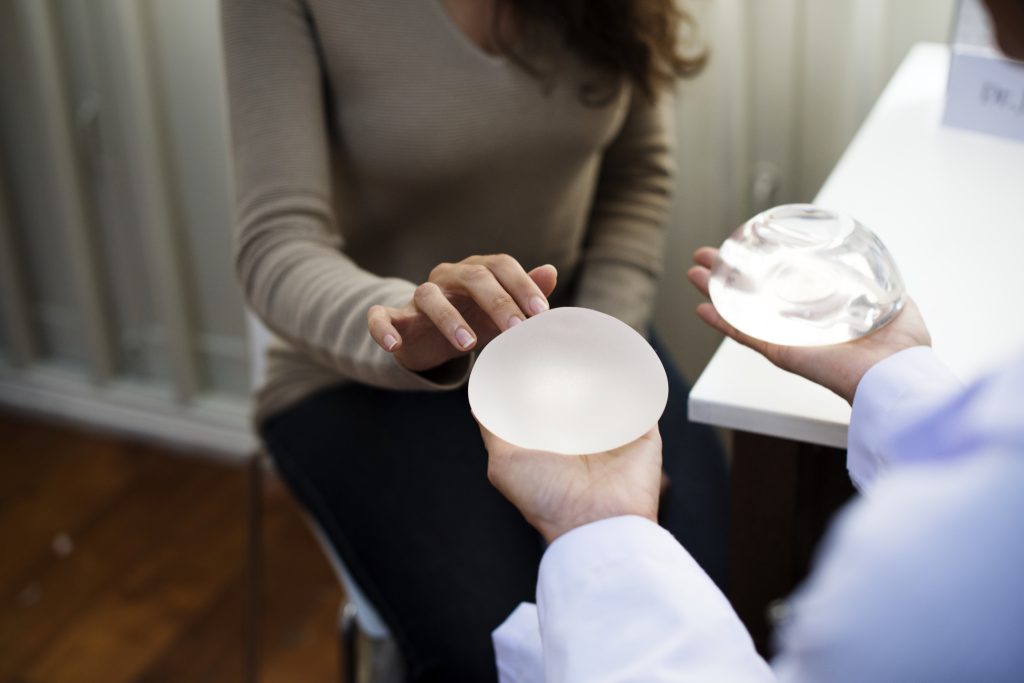Even though patients thinking about getting breast augmentation do quite a bit of research before their consultations, many women are quite surprised about the range of breast implant options available. Saline vs silicone implants is just the beginning when choosing among the options.
And beyond the choice of implant filling, breast augmentation patients also need to make decisions about implant size and profile, in addition to whether they want implants in front of or behind the chest muscle and where they want the surgeon to make incisions. In this blog post, though, we’ll focus primarily on the difference between silicone and saline implants and which one would be right for you.
Comparing Silicone and Saline Breast Implants
When choosing breast implants, women often begin by deciding whether they want silicone or saline implants. When a board-certified, experienced plastic surgeon performs breast augmentation, the results can look beautiful and natural, whether the patient chooses saline or cohesive silicone gel implants.
So, why would a patient choose one over the other? It’s all about personal preference.
Saline Breast Implants
First used in the 1960s, saline implants have an outer shell made of silicone. The plastic surgeon creates a pocket in the breast, inserts the implant shell, and fills the implant with sterile saltwater.
Pros
- Their sterile saltwater is biocompatible with the patient’s body. That means that if the shell tears or leaks, the fluid is harmless.
- Because surgeons don’t fill saline implants until after inserting them, they can make smaller incisions for saline implants than for silicone gel implants.
- Saline implants are usually less expensive than silicone gel implants. The popularity of saline implants, however, has decreased steadily for several years. Less than 15% percent of patients choose saline breast implants.
- They can be combined with fat transfer—a technique often called hybrid breast augmentation—to disguise rippling. During the surgery, the surgeon harvests fat from another area of the patient’s body using liposuction and then uses the fat to soften the look and feel of the implants. This creates more natural-looking results.
- Usually cost less than silicone implants.
Cons
- Saline implants feel firmer than natural breast tissue and move less naturally.
- They tend to be seen below the skin more easily than silicone gel, with visible rippling or wrinkling. That’s why patients with little existing breast tissue who get saline implants should have them placed behind the chest muscle.
WARNING:
This feature contains nudity. Please click OK to confirm you are at least 18 years of age and are not offended by such material.
Silicone Gel Breast Implants
The vast majority of breast augmentation patients choose silicone implants for their procedure.
Pros
- The increase in the types of cohesive silicone gel breast implants available to patients enables breast surgeons to truly customize the outcomes based on the look and feel that each patient wants.
- Silicone gel implants now come in various consistencies, including so-called “gummy bear” implants. These implants earned that nickname because the silicone gel behaves much like gummy bear candies, remaining in place even if they are cut in half.
- Patients believe silicone implants feel more like natural breast tissue.
- Silicone gel implants behave more like natural breasts than saline implants, especially when lying down.
Cons
- Silicone gel implants are pre-filled, so the incisions are a bit longer than those needed for saline implants. The difference, though, is barely noticeable because most patients choose to have incisions made in the inframammary fold, where the bottom of the breast connects to the chest wall. And, with proper care, breast augmentation incisions fade quite a bit after about a year.
- If the implants rupture or crack, patients may not notice until a diagnostic test such as a mammogram or MRI reveals it. This situation, sometimes called a “silent rupture,” can lead to the gel seeping into the body.
- These implants require more frequent monitoring. People with silicone implants should have MRI or high-resolution ultrasound screening 3 years after surgery and then every 2 years.
Which Implant Is Right for You?
Both silicone gel and saline breast implants are considered safe. Because the FDA has approved silicone gel implants for patients aged 22 or older, I recommend that younger women get saline implants for augmentation.
The bottom line, however, is that patients should choose the implants that they personally prefer. We can create beautiful, satisfying results with both types of implants. During consultations, I answer any questions patients may have about the devices and discuss the benefits and disadvantages of each type further. Neither type necessarily lasts longer than the other, and some patients may end up deciding at some point to exchange one type for the other.
If you’ve been researching breast augmentation and want to discuss your breast implant options with a breast surgeon in the Boston, MA, area, request a consultation using the online form to meet with Dr. Dax or call us at (781) 740-7840 to schedule an appointment.






Leave a Reply